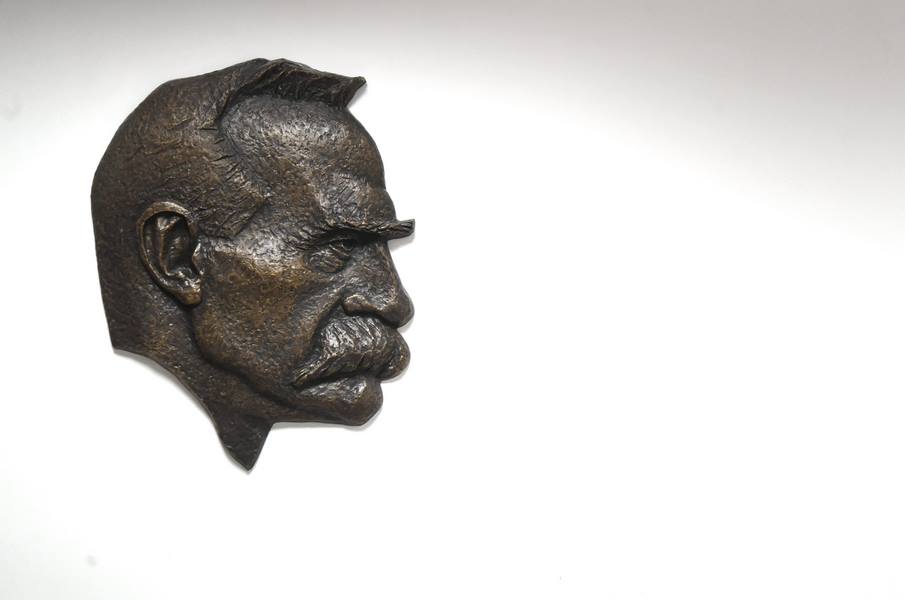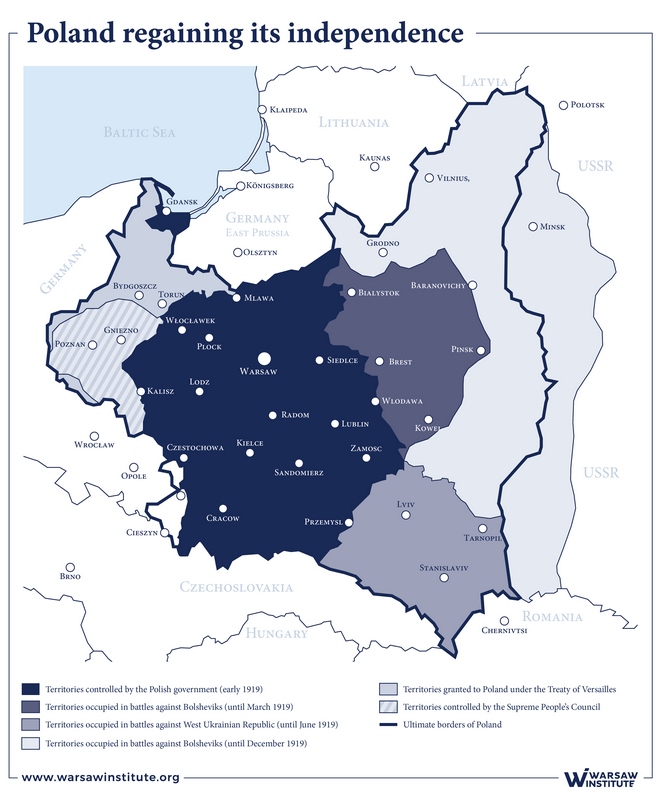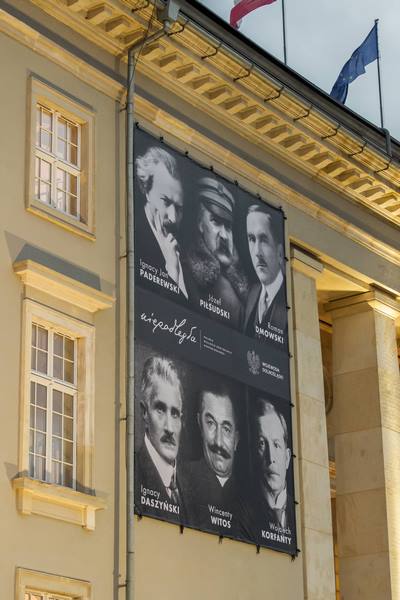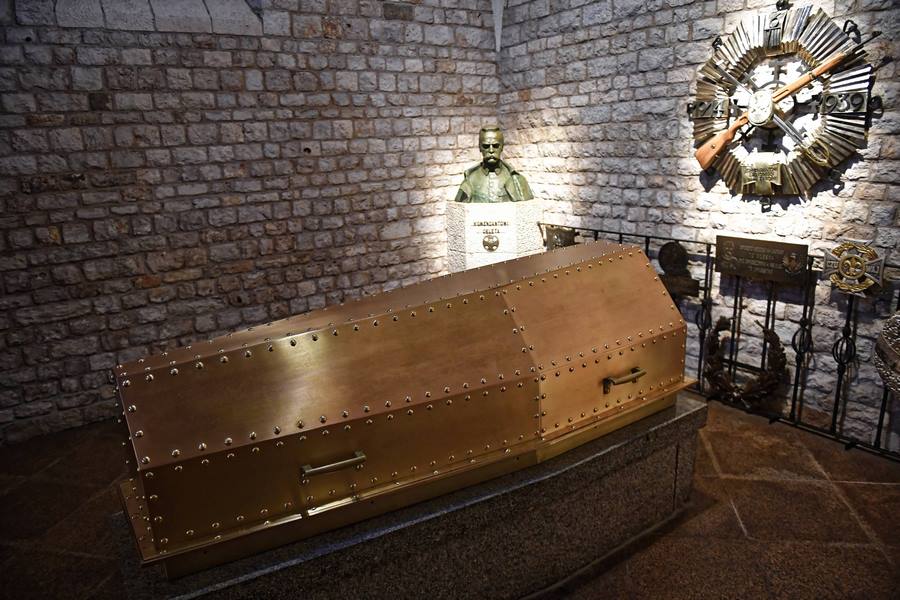THE WARSAW INSTITUTE REVIEW
Date: 31 July 2018 Author: Juliette Bretan
The map of new Europe 1918/1919: the challenges of independence for Poland
The day before that momentous Armistice was signed between the Allies and Germany – the conclusion to four years of shattering warfare – one seemingly inconspicuous man, face half-obscured with a heavy moustache, finally returned to Warsaw after spending a year languishing in a German prison.
 Warsaw, December 4, 2017. Press conference on the National Race for the 100th Anniversary of Poland’s Independence, with particular emphasis on the 100th Anniversary Supermarathon and 100-meter National Championships, as well as “Five with Piłsudski” on the 150th Anniversary of the Birth of the First Marshal of Poland. © PAP/Bartłomiej Zborowski
Warsaw, December 4, 2017. Press conference on the National Race for the 100th Anniversary of Poland’s Independence, with particular emphasis on the 100th Anniversary Supermarathon and 100-meter National Championships, as well as “Five with Piłsudski” on the 150th Anniversary of the Birth of the First Marshal of Poland. © PAP/Bartłomiej ZborowskiHis, however, had been a battle for two liberations: his own and that of his nation. Józef Piłsudski epitomized the Polish spirit, and his arrival in the war-torn Polish city, allegedly with a hero’s welcome from its citizens, marked a new start for a Polish state which had spent 123 years sliced and pummeled to fit a map of Europe which unashamedly made clear it had no place for Poles.
The landscape of the newly-independent Poland in the immediate years after WWI has Piłsudski at its very roots: released as a result of declining German clout, he was the face – the voice – of the multitudes within Poland, driving a dispatch to world leaders in the days after his return that ‘the Polish state is being established in accordance with the will of the whole nation’ and that ‘henceforth no foreign army shall enter Poland until we have formally communicated our will in the matter.’ Piłsudski, who had commanded the Polish Legions unit in the Austro-Hungarian Army, was jailed in 1917 for encouraging those under him to refuse to swear allegiance to the decaying German and Austrian forces following a German refusal to support full Polish independence. His dispatch cemented what he saw as Poland’s future – one which must be Poland’s alone – and was a message of resolve to ensure an independence the Poles alone could manipulate, swelled with a promise that the ‘Polish government will replace the rule of force…by a system built on the basis of order and justice.’[1]
Yet the Poland which rose from the ashes of war and splintered diplomacy was hardly founded in Piłsudski’s ideals of order and justice – at least, not at the start. Piłsudski had been incarcerated in the wake of the Act of the 5th November in 1916, a declaration by Germany and Austria to ensure the creation of a Polish nation, but with a catch: it would operate as a puppet-state at the mercy of the Central Powers. Piłsudski rapidly opposed this plan, eventually resulting in his imprisonment; just as the Central Powers allotted a provisional head to the Polish nation: the Regency Council.
With Piłsudski silenced, and alongside the Regency Council’s limited and careful procedures supporting Polish nationhood, there was another group of Poles taking an equally delicate tack, led by the also-mustachioed Ignacy Daszyński. Daszyński’s attitude towards the Act was one which mirrored the general feelings of Polish ambiguity towards its declaration – there was an irrefutable assertion of Polish nationhood within its pages, but this would be heavily undercut; one Pole at the reading, the journalist Stefan Krzywoszewski, summarized the Polish mood when he remarked:
“A part of our patrimony was being returned to us… but under a watchful guardianship that could become the most dangerous of all the yokes yet placed on us.”[2]

It was this uncertainty that prompted Daszyński to only move against the Central Powers following their allocation of land to the Ukrainian People’s Republic as part of the Treaty of Brest-Litovsk in early 1918. He exercised caution over the Regency Council’s ideals, preferring a social program as a counterweight. As the two groups quietly vied for power, it became apparent that all was not well in the relationship between Germany and Austria-Hungary – and so movement towards Polish independence began to blossom fast. On October 7th, the Regency Council declared an independent Polish state in Warsaw; the following day, the Polish National Committee – a Polish independence group in exile, headed by Roman Dmowski and recognized by France as quasi-governmental – petitioned the Allies for support; and two weeks later Daszyński established the Polish Liquidation Committee in Kraków to wield influence over Polish-speaking elements of Austria-Hungary.[3]
The result was pandemonium. The Regency Council, Poland’s best effort on the ground to gain land, failed to establish adequate governmental procedure, and so Daszyński leapt into the fray again, introducing the Provisional People’s Government of the Republic of Poland, which proclaimed an independent Poland in Lublin on 7th November. This government, mainly consisting of socialists, was equally inadequate to rally widespread support, though the Regency Council was too weak to suppress it – and so the country was consumed by an impasse until Piłsudski’s return.[4]
Governmental foundations
As the icon of the Polish struggle for independence – the only ideal both the Regency Council and Daszyński’s provisional government both supported – Piłsudski was recognized by both institutions as the supreme authority. But the desiccated landscape of domestic politics he returned to was to mar Poland for long after independence had been assured. After Piłsudski’s masterminding of the creation of a new government with Daszyński’s support ended in failure,[5] the staunch socialist politician Jędrzej Moraczewski was nominated as the first Prime Minister in order to push through electoral law provisions in a drive towards national elections.[6] Thus, less than a month after Poland regained independence – and in one of the first legislative acts undertaken by the new nation – women were given an equal right to vote; despite Piłsudski’s own belief that women were inadequately prepared to put their votes to good use.[7]
But domestic politics was still facing bedlam: the electoral law had been met with a tide of disapproval, and in the Greater Poland region Poles rose against German authority following a patriotic speech by Ignacy Paderewski, with fighting sustained until the Treaty of Versailles.
Then there was international dubiety. The Entente had been determined to grant Poland independence on their terms; they distrusted Piłsudski’s ideals, and knew the Polish state would eventually depend on their influence, as swathes of the new nation were facing deplorable poverty, poor infrastructure and a lack of defense mechanisms. They also had a provisional government in France under Dmowski – and with support from Paderewski – ready to be slotted into place. But Piłsudski had the people behind him – even despite a pitiful attempt at a right-wing coup in early January, which resulted in some members of Moraczewski’s government being arrested. The answer was a compromise in the form of legislative elections held in January 1919: Paderewski became Prime Minister in a coalition government – he and Dmowski would petition for Polish territory at the Paris Peace Conference –, whilst Piłsudski remained Head of State and commander-in-chief.[8]
 Wrocław, January 17, 2018. Portraits of the Fathers of Independence and defenders of Lviv from 1918 appeared on the façade of the Lower Silesian Province Governor’s Office in Wrocław as part of the celebration of the 100th anniversary of Poland’s regaining independence. © PAP/Aleksander Koźmiński
Wrocław, January 17, 2018. Portraits of the Fathers of Independence and defenders of Lviv from 1918 appeared on the façade of the Lower Silesian Province Governor’s Office in Wrocław as part of the celebration of the 100th anniversary of Poland’s regaining independence. © PAP/Aleksander Koźmiński  Cracow, July 31 2018. A metal sarcophagus containing a coffin with the body of Marshal Józef Piłsudski in the crypt under the Silver Bells Tower at Wawel Castle. © PAP/Jacek Bednarczyk
Cracow, July 31 2018. A metal sarcophagus containing a coffin with the body of Marshal Józef Piłsudski in the crypt under the Silver Bells Tower at Wawel Castle. © PAP/Jacek BednarczykTerritorial tensions
Undermining these developments, however, was the split in electoral results between right, center and left – and the haphazard means of defining electoral districts in the new state in the first place. Still there were issues of national boundaries to cement – issues international players also wanted to influence. Piłsudski promoted unifying the ethnic groups which had constituted the Polish-Lithuanian Commonwealth of 1772, allowing a diverse Polish state; whilst Dmowski intended to grasp land in the west, and envisioned an ultra-Polish nationalism at the expense of minorities. In the end, it was Piłsudski’s dream which would prevail, largely as a result of luck, with a declining Soviet power, Ukrainian insecurity, and Allied support. The Polish-Ukrainian War between 1918 and 1919 resulted in an eventual Polish victory over some eastern areas, helped in part by Allied acceptance of a Polish bulwark against Soviet expansion, though the regions gained would remain in contention throughout the interwar period. Plebiscites were held in other uncertain areas including Silesia, where successful protests by Poles between 1919 and 1921 marked an increase in Polish military clout over its neighbors.[9] The conflict in Greater Poland was resolved when the Treaty of Versailles allocated most of the area to Poland, though disputes were entrenched between Poland and Czechoslovakia across the Zaolzie region, which both nations claimed.
Polish national instability reached its peak with the Polish-Soviet War which erupted in February 1919. Watching Bolshevik domination reach a standstill, Piłsudski’s ambitions to create an Intermarium – a federation of eastern European states to emulate the Polish-Lithuanian Commonwealth – prompted efforts to expand eastwards, eventually leading to an agreement between Piłsudski and Ukrainian leader Symon Petliura to attack Soviet forces.
Social hiccups
Yet aside from Piłsudski’s charisma and charm, it was chaos which marked those early years – but a chaos belying an ever-firm Polish spirit. Though the ethnically-focused flavor of the new Sejm resulted in tangible tensions – alongside territorial disquiets and inadequate infrastructure – the centralized powers in Warsaw were determined to attempt to unite a state which had been carved into a triad of differing levels of socio-economic development, encouraging a unified and standardized approach across all facets of public life. The process began rapidly with education proposals to pave the way for a successful Polish future: the Law Concerning School Obligation in February 1919 affirmed compulsory and free schooling for young Poles, and efforts expanded with the creation of additional institutes of higher education: the Catholic University of Lublin was established in 1918; Adam Mickiewicz University in Poznań arrived in 1919, as did the AGH University of Science and Technology in Kraków.[10]
In June 1919, the first of the Minority Treaties, organized as a result of the Paris Peace Conference, was undertaken by Poles, establishing rights for groups to be taught their languages in public schools, and to create their own minority schooling system, thus setting a precedent for minority agreements made later by other nations.
But Polish society remained inherently unsteady, particularly as a result of a largely agrarian demographic and lack of successful and widespread business or entrepreneurial class. A cataclysmic result of the partitions became evident: Poland’s distance from any industrial revolution on the scale of its Western counterparts, with industrial developments during the 19th century supporting the three ruling states rather than Polish progress alone.[11] Continued Catholic endorsement of anti-industrialization and anti-urbanization exacerbated the issue, which seeped into dire infrastructural progress. In a word, Poland was fundamentally underdeveloped: there were incompatible transport links between the old partition sectors – Poles were unable to travel by train between the major cities of Kielce and Kraków, 120 kilometers apart – and some cities had only recently gained modern facilities, with the country’s second-largest city Łódź only acquiring drains and a municipal water supply after 1914.[12] Multiple currencies were in circulation, foreign investment was low, and there was limited immediate success even in agrarian fortunes, with the newly-acquired eastern regions rapidly sinking into poverty. The east faced the brunt of Polish misfortune as a result of growth rates during the period of partition, with the nation split between the wealthier western areas under German control, and the poorer eastern areas under Russia or Austria-Hungary – a divide still visible today in infrastructure maps or voting patterns, with the developed west exhibiting greater diversity and liberality.
National growth
The Small Constitution in February 1919 had established a parliamentary system in Poland, and curbed the powers of the Head of State, but did little else, and for those first formative years after independence was achieved, the country exhibited more signs of disunity and upset than national unification. Despite Piłsudski’s ambitions, minorities faced difficulties throughout the interwar period, with crumbling relations beginning from 1918; Jews faced hostility in towns such as Lwów, with the engrained public prejudice linking Jews to Bolsheviks coupled with government inability to fully quash pogroms resulting in brewing ethnic tensions. Even the Minority Treaty was taken by some to be an insult, with Polish historical tolerance cited as evidence that the measure was not needed. Throughout the period, however, those from minority backgrounds faced difficulties in gaining high office in the army or civil service; meanwhile, poverty persisted in some regions, and cultural development promoted some groups – such as Jews or Germans – over others, like Ukrainians.
But Poland enjoyed one success story in those delicate early years: culture. It was the cocktail of ethnicities and ideals so evident in the first election results to the Sejm that prompted an artistic move away from the national emblems celebrated during the partition period to a culture allowing influences from a myriad of sources. Two weeks after independence was declared, the Pod Picadorem café held its first poetry and discussion evening, in an event which would prove the foundation of the new Polish state’s first modern literary movement: Skamander. The four poets most commonly associated with the group, Jan Lechoń, Antoni Słonimski, Julian Tuwim, and Jarosław Iwaszkiewicz, discarded the patriotic concerns of partition-era literature for a focus on originality, accessibility, and above all the vibrant present. Skamander was notorious for its energy – an energy which appeared at odds with both traditional writing and modernism – and its rapid growth in a country so heavily and literally dismantled paved the way for other cultural expression: artists felt able to articulate themselves in any way they wished, and drew on sources ranging from Western, Eastern, international, ethnic ethical, religious, social and political, among others.
In fact, it was down to the undeniable lack of any core national identity that all cultural development could meet nationhood in a rich explosion of new content. Literature at first conglomerated around the Skamanderites and then the Futurists, with Anatol Stern’s work the most renowned in the latter group. Stern’s 1919 poem ‘A Naked Man in Downtown’ emphasized the close links between the human body and the city environment, with the individual experiencing a complete and comprehensive understanding of space; it was this loss of normal sense which has been cited to exemplify the links between Polish Futurism and Dada, placing this style in a more general field of absurdity. However -and indeed similar to the Skamanderites –, the central theme of Polish Futurism was again its lack of unity: it existed to shock and to alter age-old styles, but had no coherent manifesto, and individuals operating within its bounds found themselves each adopting differing and often opposing ideals.[13] Polish interwar literature really came into its own during the 1920s, as did most cultural expression, though the stumbling immediacy of some artistic productions before this time was certainly vital to later successes. As Stanisław Czernik’s 1939 essay ‘Dwadzieścia lat poezji polskiej 1918–1938’ (Twenty years of Polish poetry, 1918–1938) puts it, “after 1918, there emerged the problem of virtually two literatures: Polish literature and literature in Polish”.
Some such novel cultural production had in fact been blossoming in the wartime years: the journal Zdrój, linked to the Poznań Expressionist group Bunt, occupies a pivotal place in the development of the Polish avant-garde from 1917 through its aims to challenge the status quo in politics and art. This was a careful feat during the wartime years, but the magazine was soon able to acclimatize itself with the complexities of the new Polish state, promoting creative freedom and associating itself with other developmental artistic circles, like the Futurists. Zdrój questioned what was meant by art in Poland – a contemporary issue of national identity and modern progress with origins which lay further afield, in Germany and the West.[14]
Other artistic mediums were certainly also feeding on a steady progression of foreign influence, most notably in music and performance. The new sounds of jazz, tango and foxtrot whispered across record players and vinyl recordings over Europe and hit the Polish audiences with gusto: cabarets, theatres and dancehalls quickly spread across the nation, and celebrity culture began to grip the country by storm even before it had a government in place. Literary stars turned their hand to satirical skits or lyrics: Tuwim was writing for the Bi-Ba-Bo Theatre in Łódź as early as 1915, and newspapers began to seep the names of actors and singers, including Karol Hanusz, who brought tango to Warsaw in 1919, Zula Pogorzelska, as well as Eugeniusz Bodo, Poland’s interwar superstar.
It was in the capital that the entertainment industry truly exploded, even in the early years: by 1920, Warsaw was already home to multiple cabarets, including Qui Pro Quo, and also boasted film studios like Sfinks, which made six feature films in 1918 alone. Film was still primitive, with low budgets and substandard technology – but even by its independence Poland had already cultivated the career of its most notable actress of the era, Pola Negri, who had achieved success in her home nation before reaping acclaim in Germany in 1917, and then in Hollywood in the early twenties.
In music, the nation also somehow managed to maintain a consistent pace alongside its international – and more developed – neighbours. The innovator and cosmopolitan businessman Juliusz Feigenbaum established the record company Syrena Rekord in 1908, which had risen to become by far Poland’s most prominent recording institution even by the eve of WWI, producing 2.5 million records a year, and dabbling in music from a wide variety of ethnic groups and languages. It was down to this early prosperity that Syrena could effectively pick up where it left off when the war ended; despite some financial difficulties, the company immersed itself in the burgeoning entertainment spheres, recording cabaret artists and soon establishing a home for itself, tied tightly to the development of theatre and film.
Poland 1918–1919: year zero
It was in a December 1918 article on the precursor to the Skamander group that the newspaper Świat summarized the mood of Polish social life in the first moments after independence had been regained:
“Cafe Pod Pikadorem…it is something between an ordinary Parisian cafe, and even a Berlin cafe, and a Warsaw cabaret. It was established for the public…”
There was nothing unusual in any such institutions mentioned, where the focus was on a state of normality just brushing against something unique, and adventurous, and different. For Poles belonging to the Poland reborn onto the map of Europe in 1918, the past and future must have seemed only alien in similarity – two worlds of isolation and nation; disunity and unity; division and revision which could never touch – and yet, the Poland which emerged seemed to draw from both old and new, distilled into a concoction of multi-talented, multi-ethnic multi-hood which could only find itself in those rich – if tense – present moments.
Historians view the early years of Polish independence as a year zero; a time for the country to begin afresh from a background crippled by war, national instability and hopelessness. Of course, the year zero certainly existed in the new Polish state, with an entire nation to reconstruct – but so, in this case, did a year one, or a year ten, or a year one-hundred. The feeling of Polish nationhood did not cease to exist in the 123 years before it re-emerged on the map of Europe; lying dormant, this Poland was one on the cusp of explicit development, where the groundwork could be laid but not completely hardened. Poland in 1918 and 1919 remained flimsy, but this was a flimsiness offset by those who, mirroring Piłsudski’s politics, rapidly allowed the state’s new boundaries more freedom; who absorbed and regurgitated influences from every facet of life; who opened the eyes of the new Polish public to a richer future.
There may have been a year zero – but there was also a year 1918.
[1] ‘Independence’, Millenium Studio, http://s1millenium.kylos.pl/pilsudski/guide-to-independence/independence/?lang=en [accessed: 22 July 1018]
[2] J. Kauffman, Elusive Alliance: The German Occupation of Poland in World War I (Cambridge MA: Harvard University Press, 2015), p. 79
[3] H.A. Winkler, The Age of Catastrophe: A History of the West, 1914–1945 (New Haven: Yale University Press, 2015), p. 84.
[4] The Cambridge History of Poland, ed. W. F. Reddaway, J. H. Penson, R. Dyboski, O. Halecki (Cambridge: Cambridge University Press, 1941), p. 479.
[5] A. Chojnowski, ‘Daszyński, Ignacy’, 1914–1918 [https://encyclopedia.1914-1918-online.net/article/daszynski_ignacy [accessed: 23 July 2018].
[6] A. Nowakowska-Wierzchoś, ‘Prawa wyborcze kobiet w Polsce’, Archiwum Akt Nowych (2016) [http://www.aan.gov.pl/art,211,prawa-wyborcze-kobiet-w-polsce] [accessed: 23 July 2018].
[7] The Struggle for Female Suffrage in Europe: Voting to Become Citizens, ed. Blanca Rodriguez Ruiz, Ruth Rubio Marin (Leiden: Brill, 2012), p. 147.
[8] A. Zamoyski, Poland: A History (London 2015), p. 2792.
[9] Poland, ed. Sebastian Wormell (London 2002), p. 50.
[10] ‘Poland-History & Background’, StateUniversity [http://education.stateuniversity.com/pages/1209/Poland-HISTORY-BACKGROUND.html] [accessed: 23 July 2018].
[11] P.D. Stachura, Poland, 1918–1945 (London 2004), p. 46.
[12] D. Crowley, National Style and Nation-State (Manchester 1992), p. 55.
[13] A. Kremer, ‘Polish Futurism Revisited: Anatol Stern and his Post-War Poetry Recording’ in The Modern Language Review, (2016), p. 208.
[14] M. Bartelik, Early Polish Modern Art: Unity in Multiplicity (Manchester 2005), p. 99.
All texts published by the Warsaw Institute Foundation may be disseminated on the condition that their origin is credited. Images may not be used without permission.












